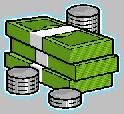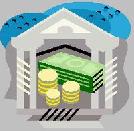
 |
|
| Financial Terms | |
| merit pay |
|
Information about financial, finance, business, accounting, payroll, inventory, investment, money, inventory control, stock trading, financial advisor, tax advisor, credit.
Main Page: financial, inventory control, stock trading, credit, accounting, money, financial advisor, business, |
Definition of merit pay
merit paya pay increment earned by achieving a specific
Related Terms:Accounts payableMoney owed to suppliers. Balance of paymentsA statistical compilation formulated by a sovereign nation of all economic transactions Break-even lease paymentThe lease payment at which a party to a prospective lease is indifferent between Break-even payment rateThe prepayment rate of a MBS coupon that will produce the same CFY as that of Clearing House Automated Payments System (CHAPS)A computerized clearing system for sterling funds Clearing House Interbank Payments System (CHIPS)An international wire transfer system for high-value Coupon paymentsA bond's interest payments.  Customary payout ratiosA range of payout ratios that is typical based on an analysis of comparable firms. Date of paymentDate dividend checks are mailed. Delivery versus paymentA transaction in which the buyer's payment for securities is due at the time of Discounted payback period ruleAn investment decision rule in which the cash flows are discounted at an Dividend payout ratioPercentage of earnings paid out as dividends. Feasible target payout ratiospayout ratios that are consistent with the availability of excess funds to make FHA prepayment experienceThe percentage of loans in a pool of mortgages outstanding at the origination Fixed-rate payerIn an interest rate swap the counterparty who pays a fixed rate, usually in exchange for a Floating-rate payerIn an interest rate swap, the counterparty who pays a rate based on a reference rate,  Full-payout leaseSee: financial lease. Graduated-payment mortgages (GPMs)A type of stepped-payment loan in which the borrower's payments Interest paymentsContractual debt payments based on the coupon rate of interest and the principal amount. Lag response of prepaymentsThere is typically a lag of about three months between the time the weighted Level payThe characteristic of the scheduled principal and interest payments due under a mortgage such that Payable through draftsA method of making payment that is used to maintain control over payments made PayablesRelated: Accounts payable. PaybackThe length of time it takes to recover the initial cost of a project, without regard to the time value of money. PaydownIn a Treasury refunding, the amount by which the par value of the securities maturing exceeds that Payment dateThe date on which each shareholder of record will be sent a check for the declared dividend. Payment floatCompany-written checks that have not yet cleared. Payments nettingReducing fund transfers between affiliates to only a netted amount. Netting can be done on Payments patternescribes the lagged collection pattern of receivables, for instance the probability that a Payout ratioGenerally, the proportion of earnings paid out to the common stockholders as cash dividends. Pay-upThe loss of cash resulting from a swap into higher price bonds or the need/willingness of a bank or Payment-In-Kind (PIK)bond A bond that gives the issuer an option (during an initial period) either to make Prepayment speedAlso called speed, the estimated rate at which mortgagors pay off their loans ahead of Prepaymentspayments made in excess of scheduled mortgage principal repayments. Production payment financingA method of nonrecourse asset-based financing in which a specified Single-payment bondA bond that will make only one payment of principal and interest. Take-or-pay contractA contract that obligates the purchaser to take any product that is offered to it (and pay Target payout ratioA firm's long-run dividend-to-earnings ratio. The firm's policy is to attempt to pay out a Zero prepaymentassumption The assumption of payment of scheduled principal and interest with no payments. ACCOUNTS PAYABLEAmounts a company owes to creditors. PaybackA method of investment appraisal that calculates the number of years taken for the cash flows from an investment to cover the initial capital outlay. PrepaymentA payment made in advance of when it is treated as an expense for profit purposes. Accounts payableAmounts owed by the company for goods and services that have been received, but have not yet been paid for. Usually Accounts payable involves the receipt of an invoice from the company providing the services or goods. Accrued expenses payableExpenses that have to be recorded in order for the financial statements to be accurate. Accrued expenses usually do not involve the receipt of an invoice from the company providing the goods or services. Bonds payableAmounts owed by the company that have been formalized by a legal document called a bond. Interest payableThe amount of interest that is owed but has not been paid at the end of a period. Loans payableAmounts that have been loaned to the company and that it still owes. Notes payableAmounts owed by the company that have been formalized by a legal document called a note. Payment dateThe date established for the payment of a declared dividend. Payroll expenseThe amount paid to employees for services rendered; synonymous with salary expense and wage expense. Payroll journalA journal used to record the payroll of a company. Payroll tax expenseThe amount of tax associated with salaries that an employer pays to governments (federal, state, and local). Payroll taxes payableThe amount of payroll taxes owed to the various governments at the end of a period. Salaries payableSalaries that are owed but have not been paid at the end of a period. accounts payableShort-term, non-interest-bearing liabilities of a business accrued expenses payableThe account that records the short-term, noninterest- dividend payout ratioComputed by dividing cash dividends for the year Payback PeriodThe number of years necessary for the net cash flows of an contingent paycompensation that is dependent on the payback periodthe time it takes an investor to recoup an Accounts payableAcurrent liability on the balance sheet, representing short-term obligations Payback methodA capital budgeting analysis method that calculates the amount of dividend payout ratioPercentage of earnings paid out as dividends. payback periodTime until cash flows recover the initial investment of the project. payment floatChecks written by a company that have not yet cleared. payout ratioFraction of earnings paid out as dividends. Balance of PaymentsThe difference between the demand for and supply of a country's currency on the foreign exchange market. Balance of Payments AccountsA statement of a country's transactions with other countries. Transfer PaymentA grant or gift that is not payment for services rendered. Current Tax Payment Act of 1943A federal Act requiring employers to withhold income taxes from employee pay. Electronic Federal Tax Payment Systems (EFTPS)An electronic funds transfer system used by businesses to remit taxes to the government. Equal Pay Act of 1963A federal Act requiring that both sexes receive equal pay Gross PayThe amount of earnings due to an employee prior to tax and other deductions. Net PayThe amount of an employee’s wages payable after all tax and other deductions have been removed. PaycardA credit card into which a company directly deposits an employee's net pay. Payroll CycleThe period of service for which a company compensates its employees. Payroll RegisterA report on which is summarized the wage and deduction information Payroll StabilizationThis calculation is used by states to determine the unemployment Sick PayA fixed amount of pay benefit available to employees who cannot Termination PayAdditional pay due to an employee whose employment is Unclaimed PayNet pay not collected by an employee, which is typically transferred Accounts PayableAmounts due to vendors for purchases on open account, that is, not evidenced Accounts Payable Days (A/P Days)The number of days it would take to pay the ending balance Lease PaymentThe consideration paid by the lessee to the lessor in exchange for the use of the leased equipment/property. payments are usually made at fixed intervals. PaybackThe length of time required for the net revenues of an investment for the net revenues of an investment to return the cost of the investment. Progress PaymentsPeriodic payments to a supplier, contractor or subcontractor for work satisfactorily performed to date. Repayment TermsThe length of time given a borrower by a lender to repay a debt and the frequency of principal payments which the borrower has to meet. Interac® Direct PaymentInstead of paying with cash or a credit card, Interac Direct payment allows you to pay for your purchase with a debit card, such as your bank card. The amount of the purchase is electronically debited, or withdrawn, from your bank account (see debit card). online bill paymentThe electronic payment of a bill via the Internet. The specified amount of the bill is electronically debited from your account. pre-authorized paymentA system where funds are electronically debited from your account on a specified date by a financial institution (e.g., bill, mortgage or personal loan payments) or perhaps an insurance or an utility company. stop paymentA service which enables you to request a 'stop' on any cheque or other pre-authorized payment, as long as the funds have not yet been disbursed. For example, you might request a stop payment on a post-dated cheque if you no longer need the product or service for which that cheque was initially written. Automatic Benefits PaymentAutomatic payment of moneys derived from a benefit. Related to : financial, finance, business, accounting, payroll, inventory, investment, money, inventory control, stock trading, financial advisor, tax advisor, credit. |